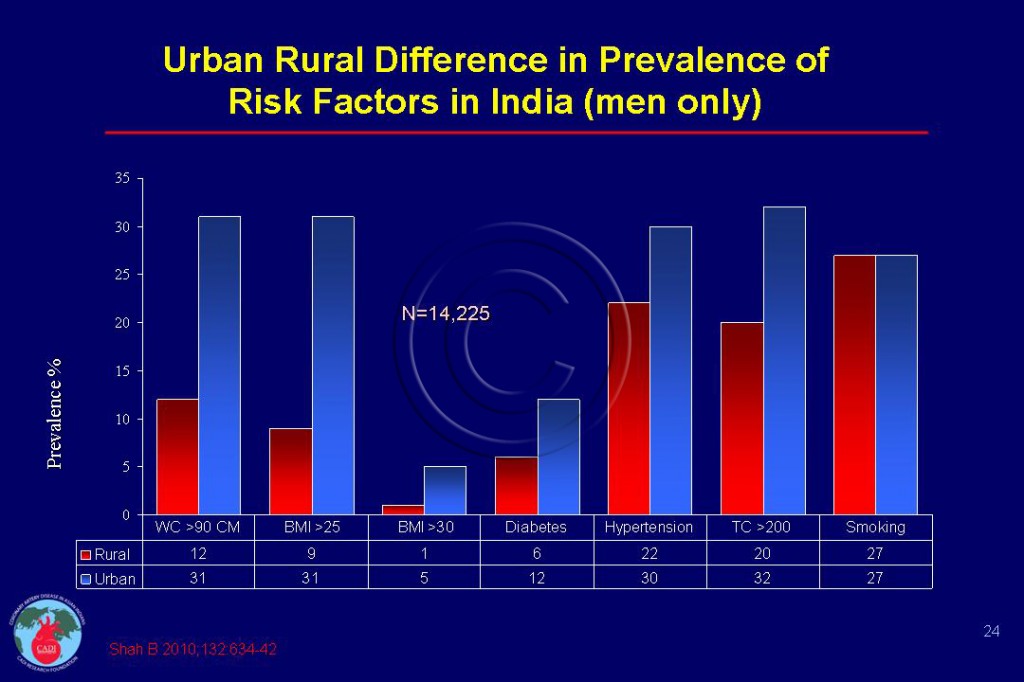Urban India
- Over the past 40 years, the coronary artery disease (CAD) rates in urban India have increased 3-fold and are now similar to that of generally more affluent Indian Diasporas and several times higher than those of other Asian countries.1-3 The prevalence of CAD is 10% in New Delhi, 11% in Chennai, and 12% in Goa.2, 4
- The prevalence of CAD in urban India is about double the rate in rural India (3-5%) and about 4-fold higher than in the US.4-6 The rates appear to be higher in South India with Kerala having a prevalence of 7% in rural areas.7
- Risk factors associated with urban lifestyle are critical as evidenced by higher rates of diabetes and CAD, despite sharing the same genetic background.8, 9 This significant urban-rural gradient indicates the crucial role of socio-economic factors associated with societal transition contributing to the CAD epidemic in India.10
- Migration from rural to urban areas is associated with increase in obesity, particularly abdominal obesity, which drives other risk factor changes such as insulin resistance, diabetes, high blood pressure, and dyslipidemia (cholesterol problems).11
- Urban men and women have higher blood pressure, dyslipidemia, and prediabetes than rural men.11-13 The rates of obesity and diabetes are more than double in urban Indians than rural Indians (Figure 024).10-12 The prevalence of metabolic syndrome is also higher in urban India.
- When exposed to reduced energy expenditure and increased caloric consumption, genetically susceptible individuals develop insulin resistance that plays a causative role in metabolic syndrome, diabetes, and premature atherosclerosis. This phenomenon occurs in parallel with urbanization, suggesting that the increased cardiovascular risk in Asian Indians may be preventable through lifestyle interventions and the judicious use of medications to attain optimal levels of blood pressure, lipids, and glucose.14
Sources
1. Yusuf S, Ounpuu S, Anand S. Global burden of cardiovascular disease: A review of evidence. In: Sethi KK, ed. Coronary Artery Disease in Indians: A Global Perspective. Mumbai: Cardiological Society of India; 1998:11-25.
2. Mohan V, Deepa R, Shanthi Rani S, Premalatha G. Prevalence of coronary artery disease and its relationship to lipids in a selected population in South India. The Chennai Urban Population Study (CUPS No. 5). J Am Coll Cardiol. 2001;38(3):682-687.
3. Gupta R, Gupta V, Sarna M. Changing trends in lipid levels in an urban Indian population. Indian H J. 2001;53:653.
4. Chaddha SL, Radhakrishan S, Ramachandran K. Epidemiological study of coronary heart disease in urban population of New Delhi. Ind J Med Res. 1990;92 (B):424-430.
5. Reddy KS, Yusuf S. Emerging epidemic of cardiovascular disease in developing countries. Circulation. 1998;97:596-601.
6. Gupta R, Gupta VP. Meta-analysis of coronary heart disease prevalence in India. Indian heart journal. 1996;48(3):241-245.
7. Raman Kutty V, Balakrishnan K, Jayasree A, et al. Prevalence of coronary heart disease in the rural population of Thiruvananthapuram district, Kerala, India. Int J Cardiol. 1993;39:59-70.
8. McKeigue PM, Ferrie JE, Pierpoint T, Marmot MG. Association of early-onset coronary heart disease in South Asian men with glucose intolerance and hyperinsulinemia. Circulation. 1993;87(1):152-161.
9. Chadha SL, Radhakrishan S, Ramachandran K. Epidemiological study of coronary heart disease in urban population of New Delhi. Ind J Med Res. 1990;92 (B):424-430.
10. Shah B, Mathur P. Surveillance of cardiovascular disease risk factors in India: the need & scope. Indian J Med Res. Nov 2010;132(5):634-642.
11. Ebrahim S, Kinra S, Bowen L, et al. The effect of rural-to-urban migration on obesity and diabetes in India: a cross-sectional study. PLoS Med. 2010;7(4):e1000268.
12. Ramachandran A, Mary S, Yamuna A, Murugesan N, Snehalatha C. High prevalence of diabetes and cardiovascular risk factors associated with urbanization in India. Diabetes Care. May 2008;31(5):893-898.
13. Ajay VS, Prabhakaran D. Coronary heart disease in Indians: implications of the INTERHEART study. Indian J Med Res. Nov 2010;132(5):561-566.
14. Gupta M, Brister S. Is South Asian ethnicity an independent cardiovascular risk factor? The Canadian journal of cardiology. Mar 1 2006;22(3):193-197.


